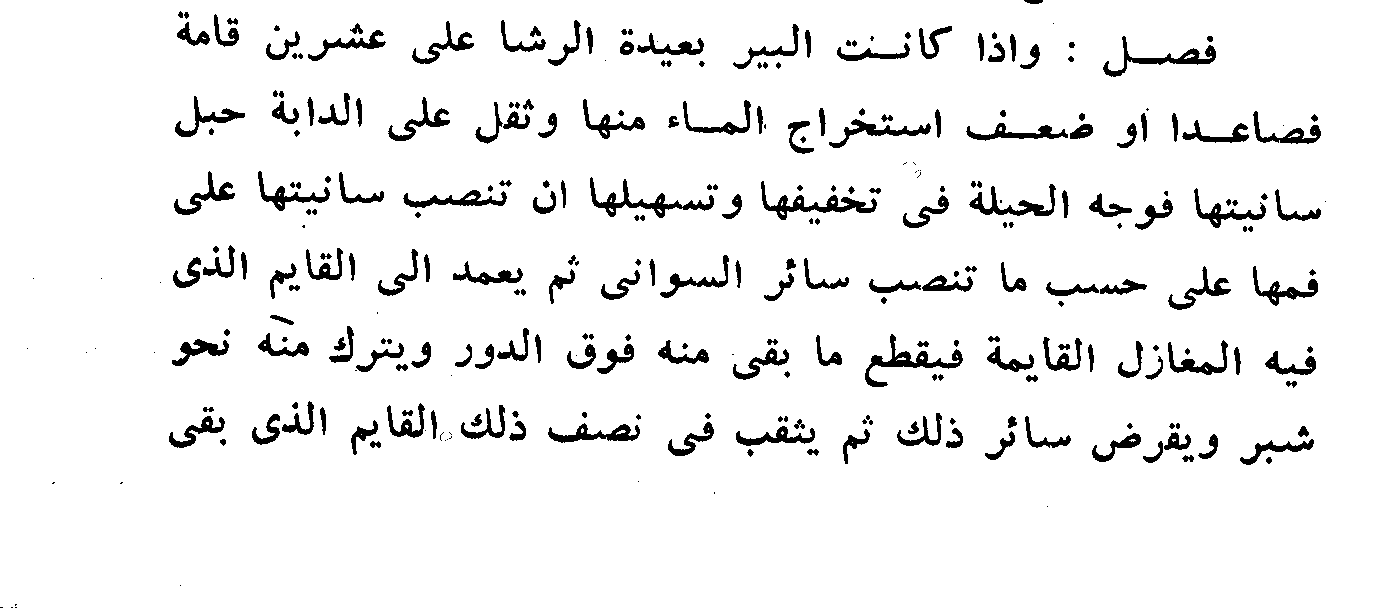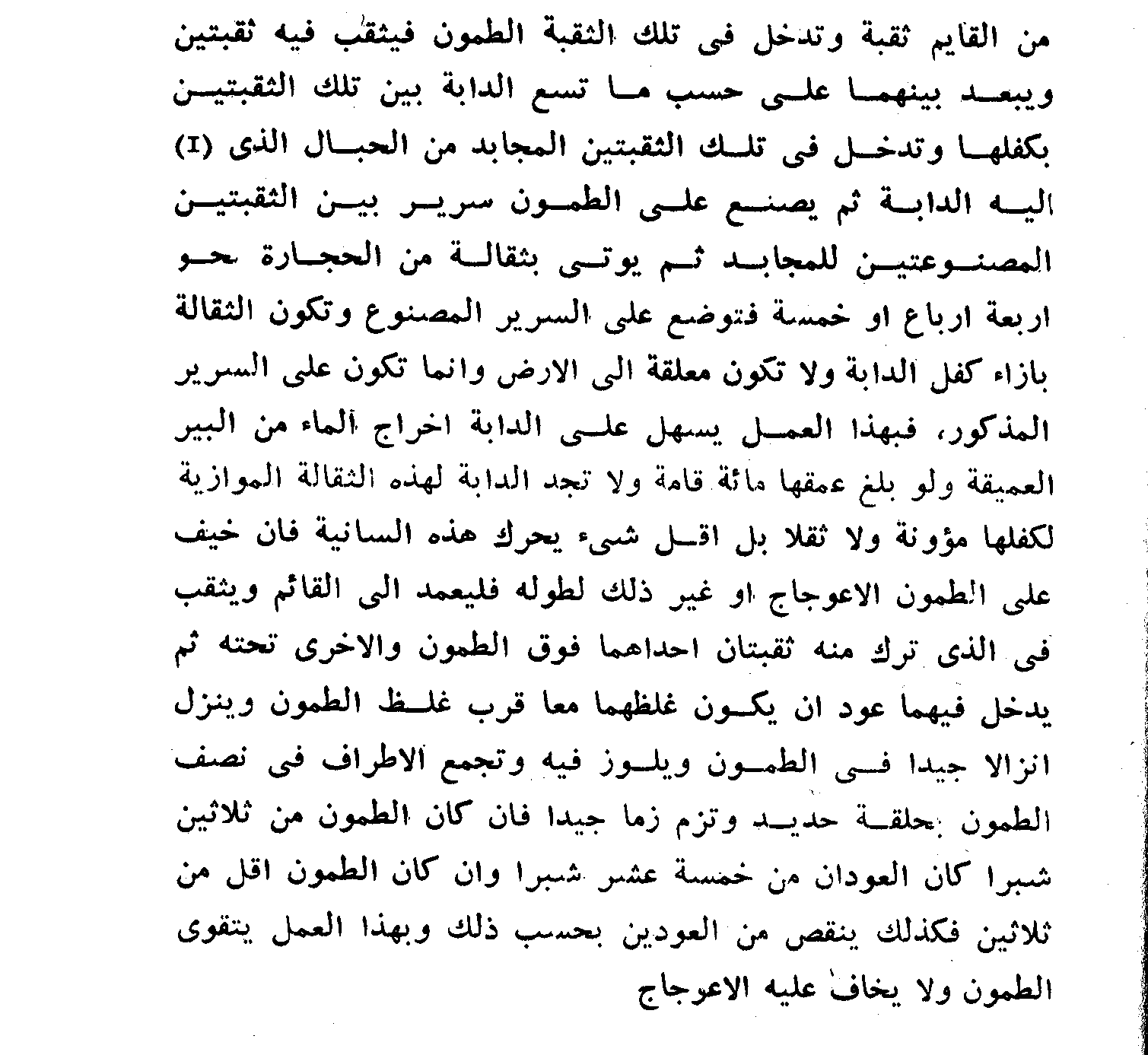
History of Science and Technology in Islam
Flywheel Effect for a Saqiya
From Kitab al-Filaha of Ibn Bassal[1]
(fl. 1038-1075)
A flywheel is attached to a rotating shaft so as to smooth out delivery of power from a driving device to a driven machine. The inertia of the flywheel opposes and moderates fluctuations in the speed of the driver and stores the excess energy for intermittent use. In other words it smoothes out the flow of power. The flywheel was utilized very early in history in potters’ wheels and in ancient Egyptian drilling devises.[2] It started to be used in machinery in Europe only in the sixteenth century. [3]
This Brief Note is about an ingenious devise that was described by Ibn Bassal in the eleventh century for utilizing the flywheel effect in a saqiya.[4] A weight is placed behind the animal on the drawbar which is rotating around the vertical shaft of the saqiya. The resulting extra inertia that is stored in the weight is required for the proper operation of the saqiya. Using a weight to produce a flywheel-effect, the operation will be smoother and the load on the animal will be minimized. The flywheel weight allows the peaks and valleys of the torque to be reduced.
The following is what Ibn Bassal says.[5] The Arabic text is given at the end of this Note.
“Chapter: if the well is deep so that its rope is more than twenty fathoms (qama)[6] [and] if the extraction of water becomes weak and the weight of the saqiya’s rope becomes heavy for the animal then the ingenuous device for making the load light and easy is to install the saqiya at the mouth of the well in a similar manner to other saqiyas. Then you consider the upright shaft that carries the pinion and you cut off the upper part leaving about one shibr (hand span) [7] in length. Then drill a hole in the middle of the remaining upright shaft. Insert the drawbar into this hole. Drill two holes along the drawbar with a space between them sufficient for accommodating the animal with its rump. The draw robes that are attached to the animal pass through these two holes. Between the two holes on the draw bar, through which pass the draw ropes, place a supporting frame or bed. On this supporting frame or bed place a weight of stones equal to four or five arba`s (Sp. Arrobas). [8] The weight will be located opposite the rump of the animal, not hanging down but resting on the bed. With this arrangement it will become easy for the animal to draw water out from the deep well even if its depth reached one hundred fathoms. The animal will not find any burden or heaviness caused by the weight opposite to its rump, and the slightest effort will cause the saniya (saqiya) to move.
If one is afraid that the drawbar will bend or something else because of its great length we will drill in the remaining part of the upright shaft two holes, one of them above the drawbar and other underneath it, and will put in them two rods of a combined thickness equal to that of the drawbar, these rods will be securely attached to the drawbar and rounded at their ends to fit on it. The ends will be securely held and tightened together with the drawbar at its middle by an iron ring. if the drawbar measured thirty hand spans in length, the two rods will be about fifteen hand spans long each, and if the drawbar will be smaller, then both rods are decreased in length in a proportionate way; and by this construction the drawbar is strengthened without fear of its bending.”


[1] Muhammad b. Ibrahim Ibn Bassal, lived in Toledo. He devoted himself exclusively to agronomy. He also was in the service of al-Ma’mun sultan of Toledo (1038-1075), for whom he wrote a lengthy treatise on agronomy (Diwan al-filaha); this work was subsequently abridged into one volume with sixteen chapters. This work, which was translated into Castilian in the Middle Ages, was published in 1955 together with the Arabic text, (see below). The treatise by Ibn Bassal is singular in that it contains no reference to earlier agronomists; it appears to be based exclusively on the personal experiences of the author, who is revealed as the most original and objective of all the Hispano-Arabic specialists.
[2] Needham, Joseph, Science and Civilization in China, Vol. 4, Part 2, CUP, 1977, p.114
[3] Gnudi, Martha Teach, and Eugene S. Ferguson, The Various and Ingenious Machines of Agostino Ramelli, Dover, N.Y., 1994, pp. 580-581
[4] The saqiya or chain of pots water raising machine is discussed in the relevant technical literature. It is called in Spanish noria. Ibn Bassal calls it saniya.
[5] Ibn Bassal, Libro De Agricultura, edited and translated into Spanish by Jose M. Millas Vallicrosa and Mohamed Aziman, Tetuan,1955, Spanish and Arabic versions. Reproduced by facsimile with a study by Expiracion Garcia Sanchez.and J. Esteban Hernandez Bermejo, Sierra Nevada, 1995. The Arabic text for this note is on pp.176-177
[6] Qama: the qama or fathom is basically 4 legal cubits = 199.5 cm. or approximately 2 metres. The English fathom is a unit of length equal to six feet (1.83 meters). Ibn Bassal considers a well to be deep if its depth is 20 qamas (bout 40 meters) or more.
[7] Shibr or span is the distance from the end of the thumb to the end of the little finger of a spread hand; In English unit of length a span is equal to 9 inches (22.9 centimeters).
[8] Rub` pl. araba, a measure of weight. Al-rub` (Spanish arroba) equals 25 Spanish pounds or 11.502 kg. Four arrobas equal 46 kg, and five equal 57.51 kg.
Copyright Information
All Articles and Brief Notes are written by Ahmad Y. al-Hassan unless where indicated otherwise.
The design of this website does not belong to Ahmad Y. al-Hassan, the design was based on common webdesign elements.
All published material are the copyright of the author (unless stated otherwise) and may not be published or reproduced in part or in whole without the express written permission of the author.